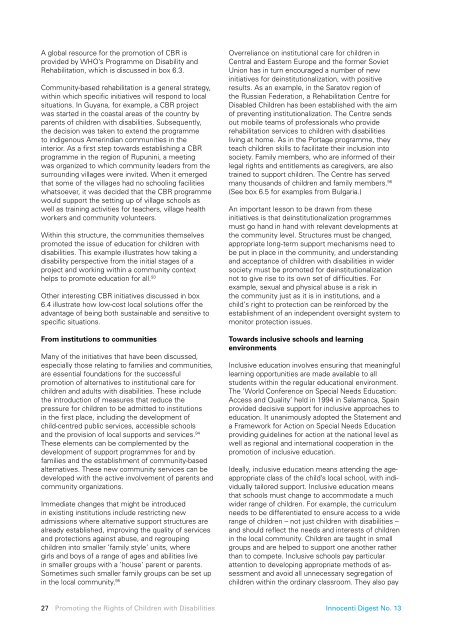Promoting the Rights of Children with Disabilities, UNICEF
Promoting the Rights of Children with Disabilities, UNICEF
Promoting the Rights of Children with Disabilities, UNICEF
- No tags were found...
You also want an ePaper? Increase the reach of your titles
YUMPU automatically turns print PDFs into web optimized ePapers that Google loves.
A global resource for <strong>the</strong> promotion <strong>of</strong> CBR isprovided by WHO’s Programme on Disability andRehabilitation, which is discussed in box 6.3.Community-based rehabilitation is a general strategy,<strong>with</strong>in which specific initiatives will respond to localsituations. In Guyana, for example, a CBR projectwas started in <strong>the</strong> coastal areas <strong>of</strong> <strong>the</strong> country byparents <strong>of</strong> children <strong>with</strong> disabilities. Subsequently,<strong>the</strong> decision was taken to extend <strong>the</strong> programmeto indigenous Amerindian communities in <strong>the</strong>interior. As a first step towards establishing a CBRprogramme in <strong>the</strong> region <strong>of</strong> Rupunini, a meetingwas organized to which community leaders from <strong>the</strong>surrounding villages were invited. When it emergedthat some <strong>of</strong> <strong>the</strong> villages had no schooling facilitieswhatsoever, it was decided that <strong>the</strong> CBR programmewould support <strong>the</strong> setting up <strong>of</strong> village schools aswell as training activities for teachers, village healthworkers and community volunteers.Within this structure, <strong>the</strong> communities <strong>the</strong>mselvespromoted <strong>the</strong> issue <strong>of</strong> education for children <strong>with</strong>disabilities. This example illustrates how taking adisability perspective from <strong>the</strong> initial stages <strong>of</strong> aproject and working <strong>with</strong>in a community contex<strong>the</strong>lps to promote education for all. 93O<strong>the</strong>r interesting CBR initiatives discussed in box6.4 illustrate how low-cost local solutions <strong>of</strong>fer <strong>the</strong>advantage <strong>of</strong> being both sustainable and sensitive tospecific situations.From institutions to communitiesMany <strong>of</strong> <strong>the</strong> initiatives that have been discussed,especially those relating to families and communities,are essential foundations for <strong>the</strong> successfulpromotion <strong>of</strong> alternatives to institutional care forchildren and adults <strong>with</strong> disabilities. These include<strong>the</strong> introduction <strong>of</strong> measures that reduce <strong>the</strong>pressure for children to be admitted to institutionsin <strong>the</strong> first place, including <strong>the</strong> development <strong>of</strong>child-centred public services, accessible schoolsand <strong>the</strong> provision <strong>of</strong> local supports and services. 94These elements can be complemented by <strong>the</strong>development <strong>of</strong> support programmes for and byfamilies and <strong>the</strong> establishment <strong>of</strong> community-basedalternatives. These new community services can bedeveloped <strong>with</strong> <strong>the</strong> active involvement <strong>of</strong> parents andcommunity organizations.Immediate changes that might be introducedin existing institutions include restricting newadmissions where alternative support structures arealready established, improving <strong>the</strong> quality <strong>of</strong> servicesand protections against abuse, and regroupingchildren into smaller ’family style’ units, wheregirls and boys <strong>of</strong> a range <strong>of</strong> ages and abilities livein smaller groups <strong>with</strong> a ’house’ parent or parents.Sometimes such smaller family groups can be set upin <strong>the</strong> local community. 95Overreliance on institutional care for children inCentral and Eastern Europe and <strong>the</strong> former SovietUnion has in turn encouraged a number <strong>of</strong> newinitiatives for deinstitutionalization, <strong>with</strong> positiveresults. As an example, in <strong>the</strong> Saratov region <strong>of</strong><strong>the</strong> Russian Federation, a Rehabilitation Centre forDisabled <strong>Children</strong> has been established <strong>with</strong> <strong>the</strong> aim<strong>of</strong> preventing institutionalization. The Centre sendsout mobile teams <strong>of</strong> pr<strong>of</strong>essionals who providerehabilitation services to children <strong>with</strong> disabilitiesliving at home. As in <strong>the</strong> Portage programme, <strong>the</strong>yteach children skills to facilitate <strong>the</strong>ir inclusion intosociety. Family members, who are informed <strong>of</strong> <strong>the</strong>irlegal rights and entitlements as caregivers, are alsotrained to support children. The Centre has servedmany thousands <strong>of</strong> children and family members. 96(See box 6.5 for examples from Bulgaria.)An important lesson to be drawn from <strong>the</strong>seinitiatives is that deinstitutionalization programmesmust go hand in hand <strong>with</strong> relevant developments at<strong>the</strong> community level. Structures must be changed,appropriate long-term support mechanisms need tobe put in place in <strong>the</strong> community, and understandingand acceptance <strong>of</strong> children <strong>with</strong> disabilities in widersociety must be promoted for deinstitutionalizationnot to give rise to its own set <strong>of</strong> difficulties. Forexample, sexual and physical abuse is a risk in<strong>the</strong> community just as it is in institutions, and achild’s right to protection can be reinforced by <strong>the</strong>establishment <strong>of</strong> an independent oversight system tomonitor protection issues.Towards inclusive schools and learningenvironmentsInclusive education involves ensuring that meaningfullearning opportunities are made available to allstudents <strong>with</strong>in <strong>the</strong> regular educational environment.The ’World Conference on Special Needs Education:Access and Quality’ held in 1994 in Salamanca, Spainprovided decisive support for inclusive approaches toeducation. It unanimously adopted <strong>the</strong> Statement anda Framework for Action on Special Needs Educationproviding guidelines for action at <strong>the</strong> national level aswell as regional and international cooperation in <strong>the</strong>promotion <strong>of</strong> inclusive education.Ideally, inclusive education means attending <strong>the</strong> ageappropriateclass <strong>of</strong> <strong>the</strong> child’s local school, <strong>with</strong> individuallytailored support. Inclusive education meansthat schools must change to accommodate a muchwider range <strong>of</strong> children. For example, <strong>the</strong> curriculumneeds to be differentiated to ensure access to a widerange <strong>of</strong> children – not just children <strong>with</strong> disabilities –and should reflect <strong>the</strong> needs and interests <strong>of</strong> childrenin <strong>the</strong> local community. <strong>Children</strong> are taught in smallgroups and are helped to support one ano<strong>the</strong>r ra<strong>the</strong>rthan to compete. Inclusive schools pay particularattention to developing appropriate methods <strong>of</strong> assessmentand avoid all unnecessary segregation <strong>of</strong>children <strong>with</strong>in <strong>the</strong> ordinary classroom. They also pay27 <strong>Promoting</strong> <strong>the</strong> <strong>Rights</strong> <strong>of</strong> <strong>Children</strong> <strong>with</strong> <strong>Disabilities</strong> Innocenti Digest No. 13
















